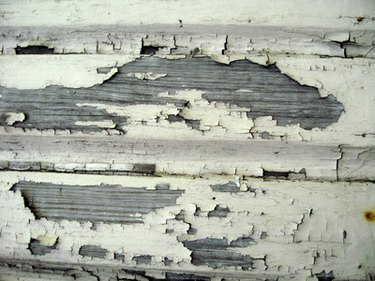Things You'll Need
Tarp
1-mm plastic sheeting
Duct tape
Water
Safety goggles
Gloves
Respirator
Liquid paint remover
Scraper
Sandpaper
Sander with HEPA filter
Heat gun
Plastic bags

A major danger for people who own older homes is contamination from lead paint. Lead is a highly toxic substance that, when ingested or absorbed into the body, can cause severe medical problems, especially for children. Any home built before 1980 is at risk for containing lead, and the older the home is, the more likely it is that there is lead paint. You can remove the lead paint yourself, but you will need to take special precautions to protect yourself, your family and the environment from lead contamination.
Interior Removal
Step 1
Remove furniture away from the windows where you will be working. Cover up any large objects that cannot be moved.
Video of the Day
Step 2
Turn off the heating, air conditioning and ventilation units throughout the house.
Step 3
Close all the vents in the room and then cover them up and seal them shut with 1-mm plastic sheeting and duct tape.
Step 4
Turn off the power to any outlets that are near the window if you will be wet sanding.
Step 5
Cover the floor around the area that you'll be working and then wash off the windows with water.
Step 6
Put on safety gear. This includes safety goggles, gloves and respirator. Make sure that you have no skin exposed.
Step 7
Scrape off the paint. There are several methods that you can use for this. You can use a liquid paint remover, applying it to the window frame (following the manufacturer's instructions) and scraping it off by hand. You can sand it off by hand or using a power sander equipped with a HEPA filter. If sanding by hand, do not sand the surface when it's dry; keep wetting it down to eliminate dust. Or you can use a low temperature heat gun to heat the paint and then strip it off by hand.
Step 8
Clean up all of the paint chips and wash any areas that were contaminated with lead dust. Place all paint chips and contaminated rags or cloths into double-plastic bags. Contact your state or local government to find out how to dispose of the waste.
Exterior Removal
Step 1
Turn off and cover all ventilation units that are in the vicinity where you will be working. Let your neighbors know what you're doing ahead of time so that they can take any precautions that they feel are necessary. Work on a day where the weather is calm to minimize the amount of dust and debris floating around.
Step 2
Cover the ground in the area that you'll be working with a tarp to prevent contaminating the environment.
Step 3
Wash the windows and frame with your hose.
Step 4
Take the safety precautions outlined above.
Step 5
Utilize the same measures as outlined previously, scraping, sanding, chemical remover and/or a heat gun.
Step 6
Clean up the debris and materials and dispose of them in plastic bags and according to local ordinances.
Video of the Day